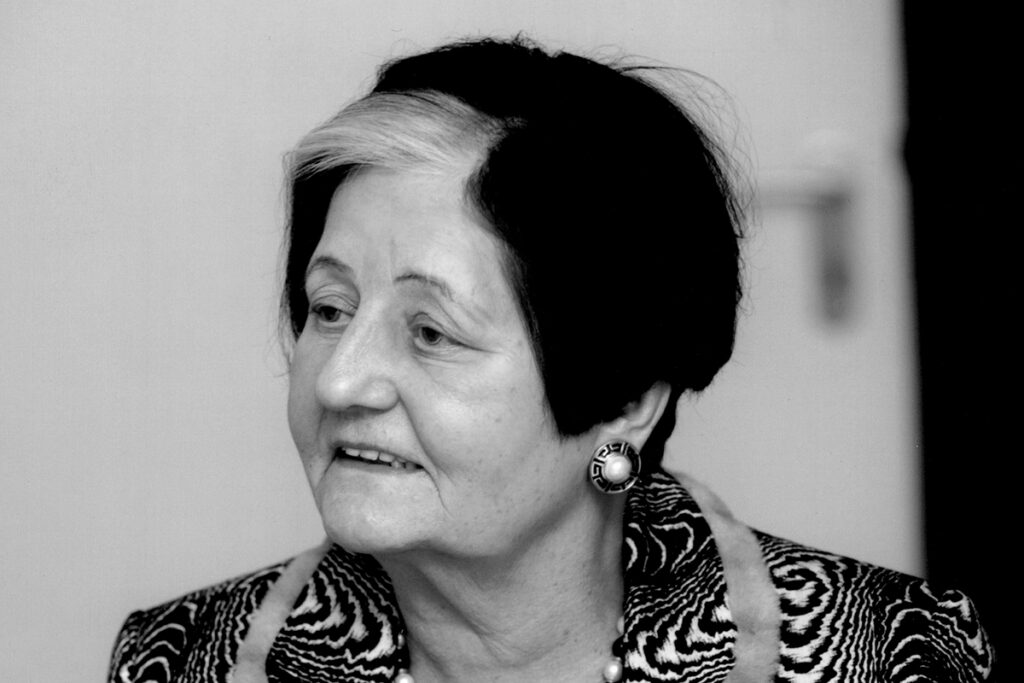Elisabeth
Nay-Scheibler
A Commemoration
A remarkable person and eye-witness to the second half of the 20th century has left us. With her what we now think of as the Modernist era draws to a close. She was born as Elisabeth Kerschbaumer on October 20, 1927, in Munich, where she grew up and early on came in contact with fine art, not only in her parental home, but also thanks to encouragement by her uncle Anton Kerschbaumer, a painter who exhibited at the Galerie Günther Franke in Munich.
This would be a fateful place for her, for Franke told the schoolgirl about the art of the “degenerates” he showed to select clients in the back room of his gallery during the Nazi period. In 1946 she began her chosen life devoted to art as a volunteer at Franke’s, which had just moved into the Villa Stuck. There Elisabeth Kerschbaumer became familiar with the world of art, for collectors like Bernhard Sprengel, Günther and Carola Peill, and Herbert Kurz were regular visitors at Franke’s, and she came to know art dealers like Curt Valentin and Heinz Berggruen, publishers like Kurt Wolff and Reinhard Piper—but most of all artists.
Decisive for her later life was her encounter with Ernst Wilhelm Nay, who showed his Hecate Pictures at Franke’s in 1946. Although Curt Valentin offered her a job in New York, she remained close to Nay. Her friendship with the painter, twenty-five years her senior, culminated with their marriage in 1949.
After two years in Hofheim im Taunus, the couple moved into a small apartment in Cologne in 1951. They soon acquired a circle of friends made up of collectors, museum people, writers, scholars, and friends of art. Werner Haftmann, Will Grohmann, Carl Georg Heise, and Max Imdahl became important interpreters of Nay’s art. The gallery Der Spiegel regularly exhibited Nay’s work. Elisabeth Nay was always at hand, organizing their daily lives, maintaining contacts, dealing with correspondence, contracts, etc. She became a privileged witness to her time, one who both experienced the Federal Republic’s cultural awakening in the immediate postwar period and, as far as Nay was concerned, participated in it. She accompanied him on his travels associated with growing American interest in his work. And again and again the couple travelled to Greece, either Mykonos or Crete. Elisabeth Nay learned French, as she also needed to deal with developments in France. Nay became increasingly successful, and by 1959 they were able to build a simple house with an atelier in Cologne-Lindenthal after plans by the then young architect Erwin Zander, but with important contributions of their own. It would become a Modernist statement.
After an atelier house had been established in Bavaria in 1963, Elisabeth again came into greater contact with her homeland, which Nay had found “too beautiful” after the war. She undertook the increasing tasks associated with the management of an artist’s career that was drawing ever widening circles. She also began to write about Nay, so that she more and more assumed the role of a mediator of his art, one that became a main purpose in life after Nay’s sudden death in April 1968. She organized exhibitions and collaborated on films about Nay. Her interest turned to prehistoric art, which led to the publication in 1981 of her book and film Faces of the Stone Age.
In 1979 she married Christoph Scheibler, whom she had known since the mid 1950s, a collector and friend who had had a lively interest in Nay and championed him.
Beginning in the 1980s she concerned herself intensively with the scholarly study of Nay’s œuvre. First came the 2-volume catalogue raisonné of his paintings, in 1987 and 1990, compiled by Aurel Scheibler. This was followed by the especially comprehensive catalogue raisonné of the works on paper, published by Magdalene Claesges. When Elisabeth Nay-Scheibler established the Ernst Wilhelm Nay Foundation in 2005 she demonstrated her foresight, assuring future attention to Nay’s work, which occupies an outstanding place in the art of the 20th century.
Elisabeth Nay-Scheibler was the ideal partner for an extraordinary man and artist. She stood by Nay steadfastly, even when there were difficult situations to overcome. Her knowledge of human nature paired with humor, her missionary zeal in the cause of modern art, her unerring sense for quality, and her wide-ranging interests in art, history, and cultural developments made Elisabeth Nay-Scheibler an imposing figure. Her energetic commitment to Nay were the focus of a life that led her from the back room at Günther Franke’s to an exemplary cosmopolitanism. She died on July 24, 2020 in the atelier house in Cologne.
Siegfried Gohr

